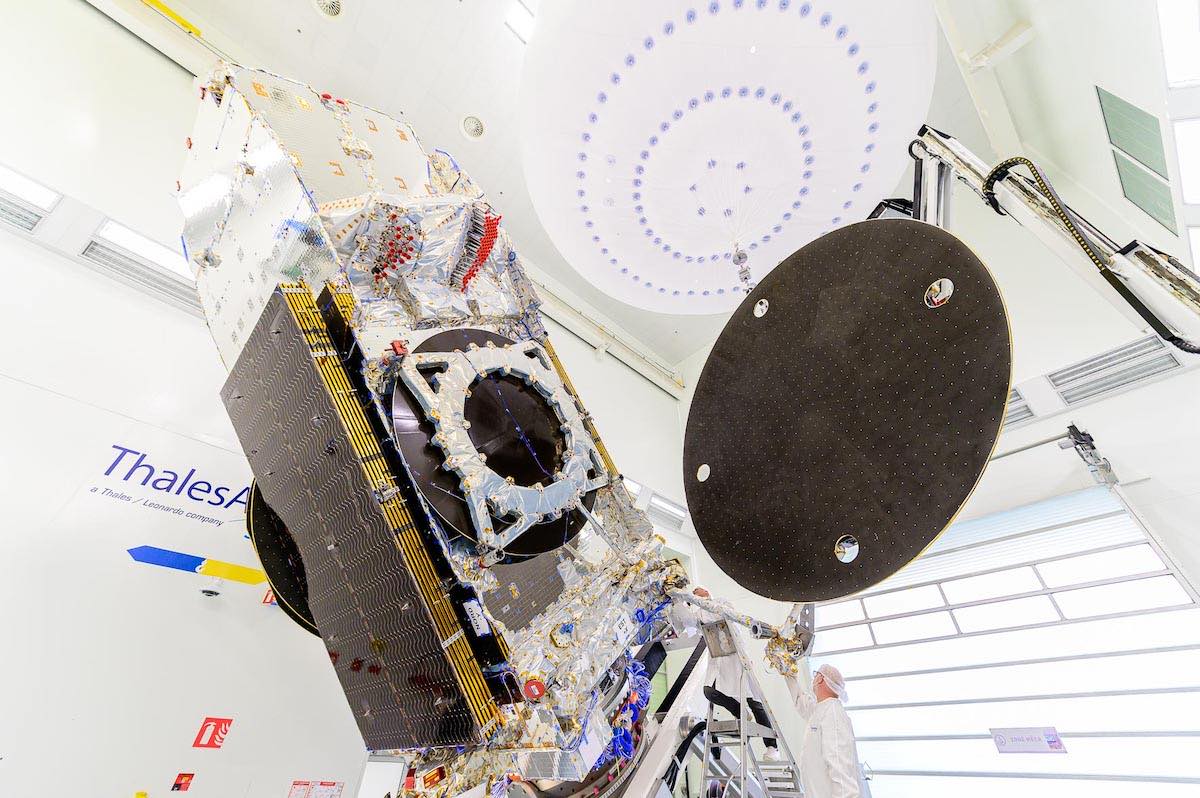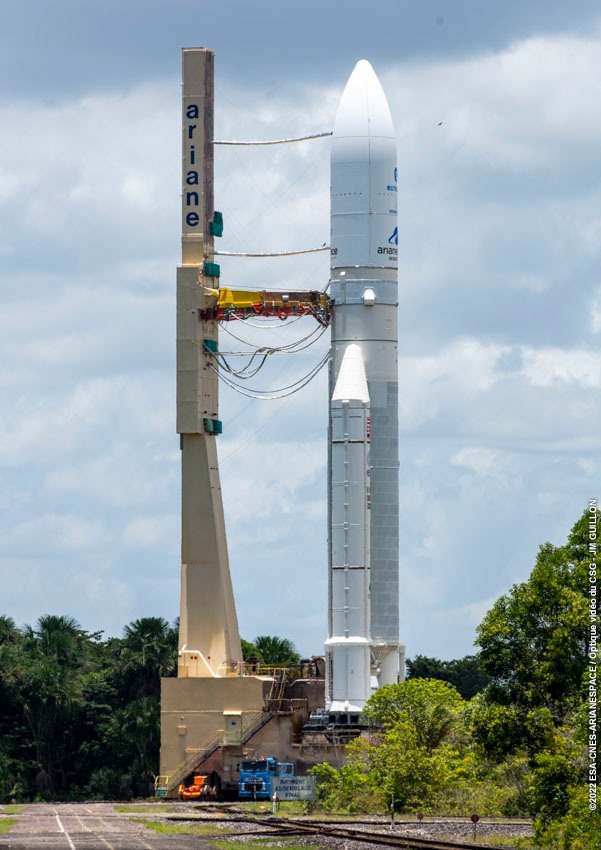
An Ariane 5 rocket is set to blast off Wednesday from French Guiana — a day later than planned due to a poor weather forecast Tuesday — with a Eutelsat-owned satellite designed to beam broadband internet signals across Europe from a position in geostationary orbit.
Billed as the most powerful communications satellite ever built in Europe, the new spacecraft is riding as a solo passenger on the European Ariane 5 rocket set for liftoff from the Guiana Space Center, the European-run spaceport in French Guiana. The launch window Wednesday opens at 5:45 p.m EDT (2145 GMT; 6:45 p.m. French Guiana time) and extends for an hour and 26 minutes, according to Arianespace, the French company that operates the Ariane 5 rocket and markets Ariane 5 launch services.
Eutelsat Konnect VHTS (Very High Throughput Satellite) was built by Thales Alenia Space, which assembled and tested the satellite in Cannes, France. Thales delivered the spacecraft to French Guiana earlier this summer by boat, a slower mode of transportation than usual due to the unavailability of Russian-owned cargo planes in Europe following Russia’s invasion of Ukraine.
The new Eutelsat spacecraft weighs more than 7 tons (about 6.4 metric tons), and will provide Ka-band connectivity for European markets, including fixed broadband customers — such as homes and businesses — and in-flight WiFi users flying across Europe on airliners. The satellite’s main body stands about 29 feet (8.8 meters) tall, as high as a three-story building.
Eutelsat Konnect VHTS will ride to orbit on one of just four Ariane 5 rockets remaining in Arianespace’s inventory. The Ariane 5, in service since 1996, is being retired in favor of the next-generation Ariane 6 rocket, a launcher European officials say will be cheaper to operate and more competitive in the global launch market.
The Ariane 5 was once dominant in commercial launch business, but lower-cost launch services from SpaceX’s partially reusable Falcon 9 rocket have eroded Arianespace’s position. The Ariane 6 is an expendable design, like the Ariane 5. But Arianespace has secured contracts to launch European government missions and satellites for Amazon’s Kuiper broadband network on the Ariane 6, now scheduled to debut next year.
Ground crews in French Guiana began stacking the Ariane 5 rocket in July for the Eutelsat Konnect VHTS mission, following the previous Ariane 5 launch in June. Teams raised the Ariane 5’s cryogenic core stage on its mobile launch platform, added two solid rocket boosters, then installed the Ariane 5’s upper stage and avionics bay inside the space center’s launcher integration building.
The Ariane 5 then rolled to the nearby final assembly building to receive the Eutelsat Konnect VHTS payload. Technicians then lowered the rocket’s nose cone, or payload fairing, over the Eutelsat satellite to complete the assembly of the 180-foot-tall (55-meter) Ariane 5 launcher.
Arianespace rolled the Ariane 5 rocket the 1.7-mile (2.7-kilometer) journey to its launch pad in French Guiana on Monday, in preparation for a launch window Tuesday. But officials announced Tuesday that the mission would be delayed 24 hours until Wednesday evening, blaming a bad weather forecast at the launch base.

The Ariane 5 launch team will load super-cold liquid hydrogen and liquid oxygen propellants into the rocket during an all-day countdown Wednesday, culminating in a seven-minute automated sequence to configure the launcher for flight. The rocket’s Vulcain 2 main engine will light as the countdown clock reaches zero, followed by ignition of the two solid-fueled boosters around seven seconds later.
The rocket will climb off the launch pad with 2.9 million pounds of thrust and head east over the Atlantic Ocean. The rocket will surpass the speed of sound in less than a minute, then jettison its spent solid rocket boosters about 2 minutes and 20 seconds into the mission.
The Ariane 5’s Swiss-made nose cone will separate about a minute later. The core stage will continue firing until nearly nine minutes into the flight, when its engine will shut down and the main stage will jettison to fall into the Atlantic Ocean off the coast of Africa.
An upper stage powered by a hydrogen-fueled HM7B engine will ignite to propel the Eutelsat Konnect VHTS payload into a highly elliptical “supersynchronous” transfer orbit stretching 37,500 miles (60,351 kilometers) above Earth at its highest point, with an inclination of 3.5 degrees to the equator. Deployment of the Eutelsat Konnect VHTS spacecraft is scheduled nearly 29 minutes after liftoff.
Eutelsat Konnect VHTS is built on Thales’s Spacebus Neo spacecraft platform, with an all-electric propulsion system for orbital maneuvers. After deploying its power-generating solar panels, the satellite will use its low-thrust but fuel-efficient plasma engines to steer into a circular orbit more than 22,000 miles (nearly 36,000 kilometers) over the equator. It will take up to a year for the spacecraft to reach its final orbit and complete testing, with entry into commercial service planned in the second half of 2023.
Satellites using plasma thrusters take longer to reach their final operating orbit than spacecraft with more powerful liquid-fueled rocket engines. But they require much lower fuel loads, meaning their owners can launch them on a smaller rocket or replace propellant mass with payload mass, such as antennas, electronics, and transponders in the case of a commercial communications satellite.
Eutelsat Konnect VHTS carries a Ka-band payload with 500 Gbps of communications capacity. Eutelsat ordered the new satellite from Thales in 2018 after negotiations with Viasat fell apart on a proposed joint geostationary broadband satellite for Europe.
The new satellite has seven times the capacity of the Eutelsat Konnect satellite, a previous broadband spacecraft launched in 2022. Major European telecom companies, such as Orange in France and Telecom Italia Mobile in Italy, have committed to using broadband capacity from Eutelsat Konnect VHTS. Thales Alenia Space will sell broadband capacity to government customers.
“With Eutelsat Konnect VHTS we are bringing connectivity to a next level,” Pascal Homsy, Eutelsat’s chief technical officer. “Defying the odds, it is the most powerful satellite to join the Eutelsat fleet. It will deliver 230 beams over Western Europe and is equipped with a Digital Transparent Processor of 5th generation which will give a considerable advantage in terms of frequency flexibility on-board.”
Email the author.
Follow Stephen Clark on Twitter: @StephenClark1.
